| Where there's a will... |
| - Wills are recorded according to the date on which they were proved, not according to the date of death.
- Remember that the will might not have been proved in the local archdeaconry court: you might need to widen your search area.
- It could take time to prove a will so don't necessarily expect to find it immediately after the death. If it was complicated or if anyone contested the will it might have taken even longer.
- Before 1882 married women could not legally own property so rarely left a will but single women or widows may have left one. |
'I bequeath everything to my beloved wife Alice.' My maternal grandfather, James Cope, was short and to the point when he wrote his will with no mention of the house he and my grandmother had bought nor of his five surviving daughters.
Compare this with the will of my 3x great-grandfather Edward Green who died in Romiley, Cheshire in 1843, aged 66. The former headmaster of Bredbury School, Edward's will runs to several pages. After the usual preamble he consigns his body for burial 'at Hatherlow with my Beloved Wife and Infants now sleeping there'. This led me to his grave which in turn told me his wife, Mary, was buried in 1834, aged 56. One of the infants is also recorded: Millicent was buried in 1802, aged two years and six weeks.
After directing that his funeral expenses are to be paid he goes on to list houses and land in three counties, Derbyshire, Cheshire and Lancashire, giving the rental value and the names of the tenants. Much of this property and land is left to 'my Beloved Sons John Green of Romiley Hatter and William Green of Hyde Tailor and Shopkeeper'. Another son, Edwards, 'Stands Indebted to me in the sum of Fifteen Pounds' and this had to be taken into account when the balance of the estate was shared out between all the children 'Share and Share Alike'.
The names on the gravestone and in the will led to the baptisms of Edward's family in the lovely Chadkirk Chapel between 1800 and 1817. But the real bonus was that some of the land was 'Originally conveyed to me by Deed of Gift and confirmed by the Last Will and Testament of the Late John Ridgway Father of my late deceased Wife.' Knowing that Mary's maiden name was Ridgway led to their marriage on 24th October 1797 in Manchester Cathedral.
With this level of detail possible, it is always worth searching out any family wills but they can be a bit difficult to track down and this is where the indexes on TheGenealogist.co.uk (www.thegenealogist.co.uk).
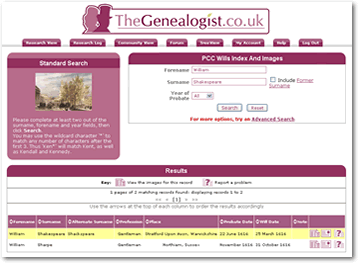 |
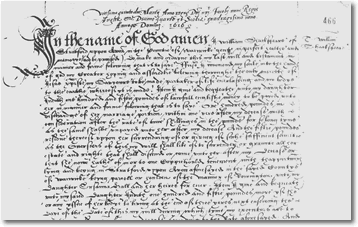 |
|
If your search in the PCC Wills Index is successful you will be rewarded with an image of the actual will itself. A search for William Shakespeare, for example, leads you to an image of his will, dated 25 March 1616, that you can enlarge to read or even download.
|
Locating Wills
The will has to be 'proved' (executors become the legal owners of the deceased's possessions but need to prove this to whoever holds the deceased's assets by applying to the court for a grant of probate) before the wishes of the testator can be carried out by the executors. Since 1858 wills have been proved wither in the local probate registry or at the Principal Probate Registry, now the Principal Registry of the Family Division, in London and there is a central index for all these.
However, locating a will proved before 1858 can be complicated. Most wills were proved in the ecclesiastical (church) courts but there was a hierarchical structure. Parishes were grouped into deaneries and several deaneries formed an archdeaconry. In turn a number of archdeaconries made up the diocese which came under the bishop's jurisdiction and each diocese then came under either the ecclesiastical provinces of York or Canterbury, with Canterbury being the senior of the two.
If the property in the will was entirely within one archdeaconry then the will would probably be proved in the local archdeaconry court. If the property was in more than one archdeaconry in the same diocese then the will could be proved in the bishop's consistory court. If the estate was in more than one diocese it would be proved in either the prerogative court of York or the prerogative court of Canterbury with Canterbury as the senior court dealing with estates that spanned both provinces. Even so this system wasn't rigid with a number of factors sometimes affecting where a will was proved. To make it even more difficult, there were small areas known as 'peculiars', many with their own courts.
If a person died without leaving a will, known as dying intestate, the court could appoint administrators to deal with the estate and this procedure produced letters of administration which were also recorded.
It is with some of these early wills and administrations that TheGenealogist's indexes are concerned, so help is at hand. Log on to the Research View page and scroll down to the Wills, Probates and Testaments section. The drop-down box offers indexes to wills for Bristol (1572-1792), Edinburgh (1601-1700), Leicestershire (1495 and 1660), Northampton (1510-1652) and Yorkshire (1389-1652) and for Irish Wills (1536-1810). In addition there is an index to the Prerogative Court of Canterbury (PCC) wills together with images of the wills themselves, a real bonus!
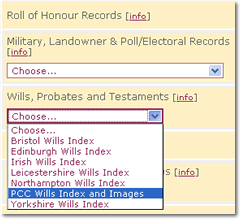
Left: Scroll down to find the Wills, Probates and Testaments section on TheGenealogist's Research View page. Click on it for the drop-down list of options.
Below: Index to Irish Wills Index, 1536-1810, on TheGenealogist.co.uk. |
| |
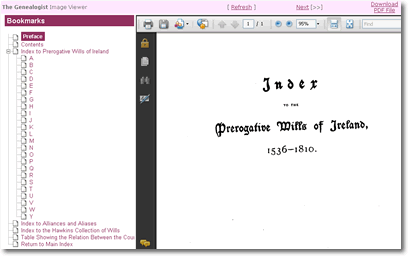 |
How to Search
Highlight whichever area you want to search, then click on 'Search', allowing time for loading. For Bristol, Edinburgh, Northampton and Irish wills only one volume appears while Leicestershire has two volumes and Yorkshire has eleven. (The PCC index works in a different way.) In order to browse the directory you need to click on the volume, even where there is only one, to highlight it before clicking on 'View Volume'. Once you have done this a split window will open. On the left are bookmarks which help you to locate more easily the entry you require. On the right is the first page of the volume containing the index. Clicking on the initial letter of your chosen surname will take you to the page containing the first entry for that letter.
Each page is a separate PDF, shown on the bar at the bottom simple as page 1 of 1, so to move to the next page click on 'Next' in the toolbar at the top. The information given for each entry varies from place to place and at different times within the same index. You might get the surname, forename and year or just a surname and initial while Edinburgh indexes can be more informative. You can search for a specific name on the current page by clicking on the binocular icon and using the search box. This will highlight the name and clicking on 'Done' will hide the search panel and reveal the whole page. You can enlarge the page and you can download it by clicking on 'Download this PDF file'.
| TreeView site tool |
With BMD certificates, census entries and perhaps a few wills, it's a good time to start putting your family tree together. Click on the TreeView tab on the Research View page, accept the terms and conditions and then you are ready to create a tree. Fill in the details of the person with whom you wish to start then click 'Save'. This is the first step on the tree and from here you can add the previous generation. Click on the '+' of either the father or the mother's box and add these details.
Use the icons to view the whole tree, families or individuals and to add photos and sources. It's easy to add, edit or delete entries and there is GEDCOM support (GEDCOM is a file format that allows genealogy files to be opened in any genealogy software program). You can also share your tree with family and friends. Click on the Help icon at the top right-hand side of the page for lots of information and ideas to help you create a family tree which you will be able to access from any computer with internet access, wherever you are!
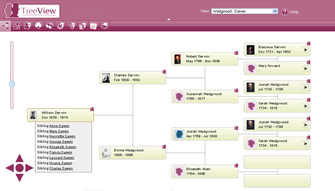
Above: The family tree of the Darwin-Wedgwood family created using TreeView. |
Instead of browsing the volume you can start by conducting a search if you prefer. Once you have selected your area, instead of clicking on 'View Volume' click on '....to search, click here' on the bar above. This will take you to a search form with forename and surname boxes. Because of the variation in information given in the indexes I found it easier, as recommended, to enter just the surname. Highlight the volume then click on 'Search', scroll down to see if there are any hits then click on the search icon at the side of a hit. A new window opens with highlighted entries visible. Click on 'Done' to reveal the full page. You can zoom in and download the PDF.
If you're lucky enough to find an entry you will need to find the actual will. For a county, try the local county record office/archives. Edinburgh wills are at the ScotlandsPeople Centre in Edinburgh and for Irish Wills contact the National Archives of Ireland.
PCC Wills
Searching the Prerogative Court of Canterbury wills on TheGenealogist is different. When you select PCC Wills Index and Images in the drop-down box and click on 'Search', a search box appears. You can enter a first name and surname and choose a probate year and/or check the 'Include former surname box'. An advanced search allows you to include the year of the will, the profession of the testator and the place. Clicking on 'Search' brings up the results. If there are too many you can simplify your checking by clicking on the column headings to rearrange the order. Click on the page icon on the right-hand side of an entry and you will be rewarded with an image of the original handwritten will which you can enlarge and read and also download.
And finally...
It's interesting to note that Edward Green's will added something else to my knowledge by what it didn't say. He mentions his sons John, William and Edward but what about my 2x great-grandfather Joshua Septimus? He was still alive and the will bequeaths 'all my wearing apparel' to 'my Five Sons' so Joshua and another son, Thomas, were accounted for but not named. Sadly this confirms, I suspect, my father's impression that our line of Greens is descended from the black sheep of the family!

Use TheGenealogist.co.uk - Part 1 - Part 2 - Part 3 - Part 4 |